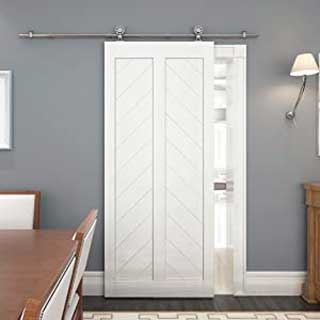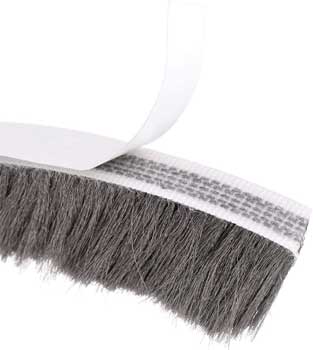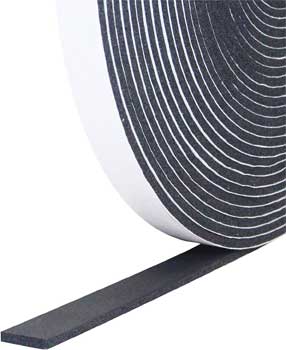If you’re looking to reduce the noise that travels through your sliding barn door, there are several effective and budget-friendly ways to enhance soundproofing.
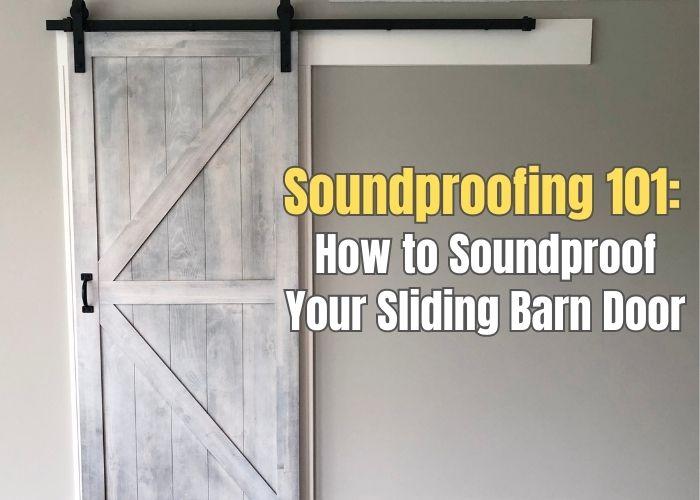
Sliding barn doors are stylish and functional additions to any home or workspace, but they often have gaps between the door panel and the frame that allow noise to pass through, compromising privacy.
Fortunately, you can significantly decrease sound transfer and increase the privacy of your rooms without investing a lot of time or money in the process.
Note: Keep in mind that you usually can’t completely seal the door, since the panel needs to slide back and forth to open and close. However, you can use the following tips to “close the gaps” and minimize air flow and sound as much as possible.
4 Ways to Soundproof a Barn Door:
1. Use a Denser, Thicker Door
Choosing a thick, solid door over a thin or hollow core option is an essential step in preventing noise flow-through in sliding barn doors. The density of the material plays a crucial role in how much sound can escape.
Solid wood or solid core doors, which are made from dense materials or have a core filled with a sound-dampening substance, offer superior insulation compared to their lighter counterparts. These doors have more effective noise-cancelling properties because their mass and density disrupt the sound waves trying to pass through.
In many cases, simply replacing a thin or hollow door with a solid panel can dramatically improve the soundproofing of a space. Alternatively, if a complete replacement isn’t feasible, adding an extra layer of wood to the existing door can enhance its density and further reduce noise leakage.
This approach not only boosts the acoustic performance but also maintains the aesthetic appeal of the barn door, ensuring it continues to blend seamlessly with the interior design while enhancing privacy and tranquility.
2. Install a Wider Sliding Door
Second, I’d choose a wider door panel for extra overlap around the doorway opening. For example, if you have a 28″ wide opening, you may want to pick a 36″ wide door panel instead of 32″. Or a 48″ barn door over a 40″ wide threshold.
The extra coverage can also reduce sound pass-through. However, not all doorways have walls that provide enough space for the added width. So, measure and check before you buy.
3. Add a Door Sweep
Installing a door sweep on the bottom of your barn door is a highly effective and affordable solution for minimizing noise transfer without the need for upgrading to a thicker door panel.
A door sweep consists of a strip of rubber, vinyl, or brush-style bristles that attaches to the base of the door, sealing the gap between the door and the floor. This not only helps in reducing noise but also prevents drafts, dust, and insects from entering the room.
The installation process is straightforward, with most door sweeps either being nailed to the door panel or featuring a convenient peel-and-stick design. This ease of installation makes door sweeps an accessible option for DIY enthusiasts and homeowners looking to improve their door’s functionality.
By ensuring a snug fit at the bottom of the door, door sweeps enhance the overall efficiency of the barn door, contributing to a quieter, more comfortable living space.
4. Use Weatherstripping
In addition, some people apply a band of weatherstripping to the back side of the barn door to help block the side air gaps. You can use a self-adhesive foam tape or a vinyl bulb weatherstripping to do this.
You can easily install self-adhesive foam tape without any tools, (or handyman skills for that matter). Plus, it also provides a decent blockade against drafts and air leaks. A vinyl bulb insulation strip consists of a flexible vinyl tubing that compresses to create a fitted seal.
Tips to Avoid Mistakes When Soundproofing Your Door:
1. If You Have Doorways with Casing or Moulding
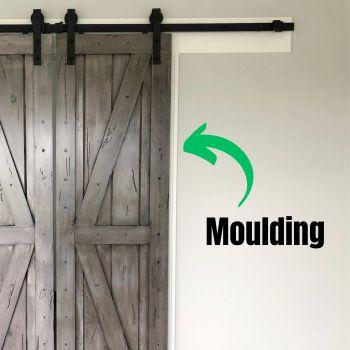
Some doorways feature moulding that finishes the frame around the door, which can pose a challenge when applying rubber or foam weatherstripping. Typically, when an insulation strip is attached to the side of the door, it may catch on the moulding, hindering the smooth sliding motion.
A practical solution is to affix the draft seal directly to the moulding on the side of the doorway that the sliding door covers when closed. This way, the strip remains out of sight and does not interfere with the door’s operation.
For those seeking an alternative approach, brush weatherstripping can be an excellent choice. Unlike foam or vinyl, a brush-style barrier features flexible bristles that easily glide over the moulding without catching, ensuring a seamless and quiet sliding action.
This method not only preserves the functionality of the door but also maintains the aesthetic integrity of the doorway. Implementing these strategies can significantly improve the efficiency of weatherproofing while ensuring that your sliding barn door operates smoothly and effectively.
2. Don’t Forget Top & Bottom Gaps
Adding brush weatherstripping to the bottom of your door panel can really help with insulation an noise. But don’t forget to insulate the top side of your door, where you may also find an air gap.
Brush weatherstripping can help seal gaps and keep out unwanted elements. It stops drafts, dust, insects and even noise from invading your space. Made with flexible bristles and attached to a metal or plastic strip, it’s a convenient solution for weatherproofing doors.
If you want to enhance soundproofing in your sliding barn door, attaching brush weatherstripping is key. It creates a barrier that effectively blocks sound waves from passing through the bottom gap of the door. Here’s how you can do it:
- Prepare the Door: Ensure the bottom of the barn door is clean and dry before attaching the weatherstripping.
- Measure and Cut: Measure the width of the door and cut the brush weatherstripping to fit accordingly using a suitable cutting tool.
- Attach the Weatherstripping: Most brush weatherstripping comes with an adhesive backing. Peel off the protective layer and carefully align the weatherstripping along the bottom edge of the door. Apply firm pressure for”stay-on” adhesion.
- Trim Excess: If needed, cut extra weatherstrip material to get a precise fit without dragging or causing obstruction.
Pros of using brush weatherstripping for soundproofing:
- Seal in Silence: The dense bristles hinder sound from sneaking through the door’s bottom, minimizing noise escaping either direction.
- Simple Setup: With minimal tools and know-how needed, installation is a cakewalk. Just peel off the adhesive backing and you’re good to go.
- Flexible and Tough: The brush-like material bends without breaking. Hence, it allows your door to glide smoothly while maintaining its effectiveness for years.
Cons of weatherstripping for noise reduction:
- Limited Soundproofing: While brush weatherstripping can help reduce noise, it might not provide as high a level of soundproofing as other specialized materials or methods.
- Maintenance: Depending on the frequency of use and environmental conditions, the bristles might wear out over time. Thus, requiring replacement.
To sum it up, soundproofing a barn door can be a straightforward, simple and affordable DIY project. In fact, you may be able to soundproof your door for about $20-30 in less than 25 minutes.
The Bottom Line:
In summary, enhancing the soundproofing of a sliding barn door is a manageable and budget-friendly DIY endeavor that can significantly improve privacy and reduce noise intrusion. Opting for a thicker, denser door material can be a straightforward method to block sound, while choosing a wider door panel offers additional coverage and sound reduction.
Incorporating a door sweep and applying weatherstripping are effective, low-cost solutions that address gaps at the bottom and sides of the door, minimizing airflow and noise leakage. For doors framed with moulding or casing, adapting the placement of weatherstripping can ensure smooth operation without sacrificing soundproofing effectiveness. These adjustments not only enhance the acoustic properties of a space but also contribute to a more controlled and comfortable environment.
Last Updated June 1, 2024

